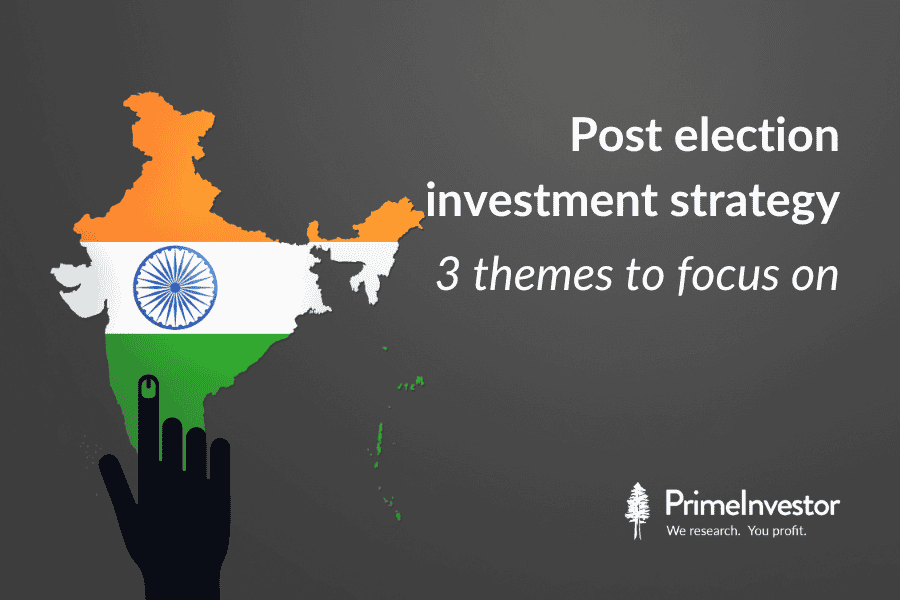With inputs from N V Chandrachoodamani
After being caught off-guard with a surprise verdict in General Elections 2024, the market may appear to be slowly consoling itself that the result is nevertheless a mandate for continuity. This may coax you to believe that the market will take off from where it left, and that the 6% Nifty 50 correction on June 4th simply gave you an opportunity to enter old favourites. If you do, you run the risk of getting your call wrong. The election result-triggered correction, in our view, was but an excuse to not only remove froth but to churn the recent market favourites out.
We think the market may not have much steam left to run merely on narratives of government spending and government (read Modi) stocks. Instead, attention on earnings growth and valuation will likely cause a churn in the market-favoured sectors from here on. And when this happens, the old favourites drop out and new ones come in.
At PrimeInvestor, we have started focusing on the areas that hold potential. This report will lay the ground for the same.
(Note: This report assumes that the NDA coalition is set to come to power at the time of issue. Any change in the actual government will be updated).

Strong GDP growth, likely to broaden
For over 2-3 weeks ahead of the election results, the stock market remained a recipient to several news items that reinforced the robustness of the Indian economy.
These range from sound GDP growth, positive credit outlook, India bond inclusion in global debt index, better than expected fiscal deficit and a windfall dividend gain.
Let us start with the GDP growth. India has been on a strong wicket in terms of GDP growth and can be expected to continue this trend. GDP growth for the March 2024 quarter was a whopping 7.8% as opposed to 6.2% a year ago. Bloomberg estimates had placed the fourth quarter growth at 7%. With this, the full year’s growth stood at 8.2% as against 7% in FY-23.
The growth was largely driven by investment demand. Among the sectors, manufacturing contributed largely to the growth. With dominant manufacturing sectors such as automobiles continuing to show tremendous growth momentum, most GDP estimates remain optimistic for FY 25 placing the forecasts anywhere between 6.7% to 7.5%.
The growth for FY-25 is expected to be more broad-based, with some focus on reviving consumption (especially through rural economy, given the election results) rather than remaining investment driven. In other words – a narrowing of gap between rural and urban consumption and private and public capex would be a shift, without much alteration in growth expectations. The coalition government could also force the way for some subsidy-driven approach to rural economy consumption revival.
With continuity in government, the coalition arrangement notwithstanding, the present growth momentum is largely expected to continue. This can be viewed as a stable factor buttressing the stock market growth.
Strengthening credit outlook and foreign flows
A nation’s credit strength not only paves the way for global inflows but also ensures affordable and adequate financing options for its domestic companies. On this front too, India has been on a sound wicket with S&P Global Ratings revising its outlook on India to positive from stable (retaining the rating at BBB+) on May 29, 2024. The rating agency has stated thus: “Regardless of the election outcome, we expect broad continuity in economic reforms and fiscal policies”.
Together with this, the Indian government bonds will receive traction with the inclusion of these bonds in the JP Morgan EM Debt index (effective June 1). You can read our detailed article on what the JP Morgan India inclusion means for Indian G-Secs here. The report will also explain how this can eventually free up domestic money for corporate lending and also bring yields down.
(Do look out for more on this and the impact on bond market in our report next week)
Fiscal deficit – the real challenge?
On May 31, before the election results were out, India had a different celebration coming from better than estimated fiscal deficit at 5.63% for FY-24, lower than the 5.8% estimate. High revenue collection from tax resulted in the government bettering its estimates. A little over a week before that, we saw the RBI declaring a whopping Rs 2.1 trillion (lakh crore) dividend payout for FY-24 to the government, backed by substantial rise in its income. This amount was way higher than the government’s budget estimate of Rs 1 trillion and 2.4 times the Rs 87,816 crore dividend payout in FY-23. It is noteworthy that the credit rating outlook came after this dividend payout.
For the uninitiated, it is important to know that fiscal prudence is a key factor when it comes to institutional investing, especially foreign money. This is so because fiscal prudence ensures spending is channelized in the most productive manner to fuel economic growth. Long-term high deficits can impact growth and stability.
Coming back, the government has a fiscal deficit target of 4.5% of GDP by FY-26. While this was beginning to look achievable, the upcoming coalition government and the new dynamics that come with it have now cast some doubt. Both the results of the elections for the ruling government as well as coalition compulsions can well force some populist spending from hereon.
What this means is that the large investment spending (government capex) may not see the high year-on-year growth that it saw in the last 5 years. Besides, some diversion to rural employment, government wage bill etc. could be small populist measures that can distract investment spending.
Nevertheless, it is our view that the excess from the dividend payout will partly help the upcoming coalition government in meeting these pressures. Still, some derailment in achieving the fiscal target can arise. This can either cause some sentiment dip (based on numbers) or provide some confidence based on what the Budget puts out.
Changing dynamics in the market – new pockets of opportunities
Now the above economic data sets are not narratives. They are facts that the market has either used or will take into account in factoring its way forward.
But in the last one year, many sectors have gone up only with narratives. These narratives were not without fundamentals but were still far too stretched in terms of the valuation they commanded. We think this is set to reverse.
The table below will tell you that the sectors that went up the most in the past year have already started correcting. Call them government stocks (or Modi stocks pre-election) or capex themes – from defense to PSU to energy and capital goods – the valuations in a good number of stocks in these sectors called for a correction. To us, the surprise election-result-tally is but an excuse to cut these down to size. And in our view, this can continue to happen.
That means the market will start looking to redeploy where there is less froth and more promise of growth with moderate valuation. On this, there can be any number of individual stock opportunities to scout for. But if we must put them out as themes, they would be as follows:
# 1 Shift in allocation to consumption
We have in the earlier part of this report stated both the compulsion (rural) and mean reversion to consumption-led growth, at least partly. While the agriculture and rural economy may receive more attention and trigger some growth in consumer staples, we are positive on the broader consumption sector, including discretionary.
Refer to the Nifty India Consumption Index when we mention Consumption. It includes FMCG, Auto, Consumer services, consumer durables and healthcare. And as the shift from the overvalued defense or capital goods segments by way of profit booking happens, some allocation shift is likely to the consumption segment. This sector’s better cash flow profile and valuations would be good grounds to command such a shift.
Just to make the comparison, the Nifty India Defence index had Price to Earnings (PE) and Price to book (PB) ratios of 58 and 15.6 respectively, compared with the Nifty Consumption index PE and PB of 48 times and 8.9 times respectively. The table above will tell you that Consumption is among the poorer performers in the past year.
At PrimeInvestor, while we have added this broad consumption theme-based stocks to Prime Stocks, for those wanting to play a focused and concentrated approach our Prime trends Consumption smallcase would be a good bet. This smallcase (a separate subscription-based product on smallcase platform) will be open for a short window as we wish for investors to time their entry into this medium-term theme.
Check more about Prime Trends Consumption here.
(If you are new to the concept of smallcase please read this - What is smallcase? Note that smallcases are not part of your PrimeInvestor subscription and is a separate research product offered by PrimeInvestor on smallcase platform)
For those of you not wanting to participate in stocks, Prime Funds offers consumption-based theme fund to invest in.
#2 Banking and financials – good entry points
Despite commanding a heavy weight in the Nifty index, this sector has not found takers among the retail investors in the stock markets in recent times as money gravitated to the defense and capex pack. With a stable economy, demand from private capex and consumption can all be triggers for credit growth.
It needs to be understood that the sector has come out of a cyclical down-turn between 2013-2019 and a new lending cycle developed and accelerated post Covid. Lenders, especially banks, are not only very well capitalised, but their core financial metrics that lead to mid to high teens RoE have come back in the last two years. Even PSU banks seem in a position to raise money from capital markets at this point of time – indicating growth support rather than government support (a rare occurrence in the PSU space). Barring minor variations in their key performance metrics, there appear to be no triggers for any major shake-up.
On the credit demand side, the environment for growth for those with a balanced mix of corporate and retail lending will remain healthy with private capex pick up underway. The current cycle led by global demand for industrial goods, increasing domestic manufacturing and PLI led capex are conducive for banks to garner high demand for working capital loans as well versus lumpy project loans. This growth promise coming at less-stretched valuations call for attention to this sector. In this space, we tread with caution in segments that are linked to capital markets (brokerages and other related entities) considering their volatile earnings profile.
For those of you looking for focused exposure to this space, check the following:
PrimeInvestor Finance Squared smallcase
For those of you not wanting to participate in stocks, Prime Funds has a finance-theme fund to invest in.
#3 Bottom-up stock opportunities
Apart from the above, there is no denying that there can be stock-specific opportunities that arise. For example, normal monsoon, focus on rural economy can provide a leg-up for agri themed stocks. Segments that show strong growth in manufacturing – across auto or capital goods, where earnings growth potential outweigh valuations – may continue to selectively offer pockets of opportunities. At PrimeInvestor, we will continue to scout for these pockets to deliver returns for your portfolio.
While the economy may paint a neat picture, we do think that the market’s ability to deliver at this point may be a bit stunted. Hence, keeping return expectations tame in the near to medium term will not only help find the right opportunities for the long term but also prevent burning your fingers in past favourites. In such stocks, we do think correction toh abhi baakee hai. And do not forget that a coalition government can bring with it its own drama and the market can find those opportunities to remove some froth.




12 thoughts on “Post election investment strategy: 3 themes to focus on”
Hi Vidya,
Awaiting reply.
Thanks
Replied.
Thanks Vidya. I will assume that all your SMALL CASE portfolio stocks are then covered in this website somewhere or other. It is the allocation and portfolio piece which you have put in SMALL CASE.
Hello Sir, No, the assumption will be incorrect. There may be stock overlaps but we do not have theme based 18-20 stocks from the same sector in Prime Stocks. We only seek to have across sector and market cap. Vidya
Thank you Vidya. I like the new pocket of opportunities and the overview on the table;
and the banking and financial entry points. Like the views. Dayanand Achar
Thank you sir.
Thank you.
So consumption funds and banking funds can be a lunpsum buy.. anytime frame? Or should be stp?
Your views on buy, hold, sell, partial profit booking on
Infra, pharma, IT sector funds?
Any thoughts on mid and small cap funds at current levels.
2-3 instalments of phased approach is preferred. Infra needs profit booking. Not the others. Nothing specific on mid and small cap. We have been saying there are several pockets in Mid and smallcap with froth and some with upside. So it is not a blanket approach. Vidya
Hi Vidya,
1. Asking once again please. Are you sure about Banking sector at this time? Haven’t we missed the opportunity / there’s still steam but most of it has passed. Secondly, do I need to wait for an opportune moment, when market corrects, to invest in this small case / anytime now is good? In consumption small case, I used market dips to invest.
2. Request please confirm.
Thanks and Regards
Sir, I believe we have clearly given the rationale for the sector in the article. If there is no steam left, I doubt if we would we recommending it 🙂 Whether it is convincing for you should be your call 🙂 It is very very hard to time entries in smallcases exactly. 2-3 deployment phases is the best approach.
Hello Team
I am a huge fan of your professional services with so little clutter and pin-pointed advise. Have got lot of my friends to become members as well in the last 1 year.
I believe running small case along with advisory is kind of CONFLICT OF INTEREST. Take the above article, for FINANCE/BANKING space, I cannot know your view, i need to subscribe to your SMALLCASE for same.
“For those of you looking for focused exposure to this space, check the following:
PrimeInvestor Finance Squared smallcase”
Please give a hard thought to it.
Best wishes.
Kishore
Hello Sir,
Thanks for your encouragement.
On smallcase – there is ZERO conflict of interest 🙂 PrimeInvestor is a research solutions provider and smallcase is a research product. . We have all our views on banking sector and have banking stocks and funds in PrimeInvestor. So there is nothing that you are missing in terms of our views on the sector. But building a portfolio of stocks is a different ball game. Building a portfolio requires time, resource and also a platform to enable auto rebalancing. it is next to impossible to do it yourself efficiently, unless done through such a platform. such a service will cost separately (as smallcase shares revenue on this) and cannot be clubbed with PrimeInvestor subscription. Thanks, Vidya
Comments are closed.